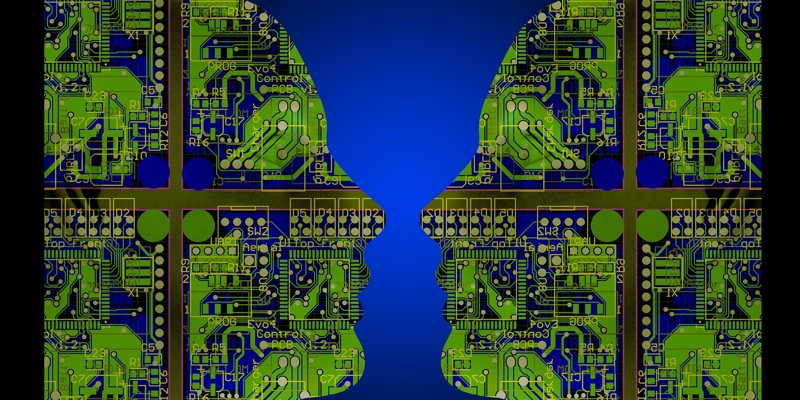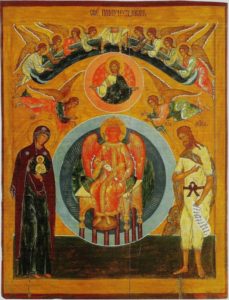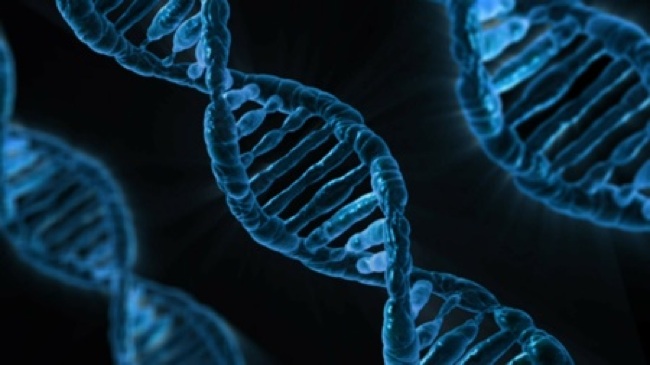
Sylvester Johnson
In my last post, I discussed Bina48, an intelligent machine engineered as part of the LifeNaut project. LifeNaut engineers have uploaded into Bina48 the memories, speech samples, and other cognitive patterns of an actual human, Bina Aspen Rothblatt. By aiming to enable humans to upload their consciousness to a machine that can operate indefinitely, the LifeNaut project seeks to transcend human biology to achieve technological immortality. In this sense, this intelligent machine is an early installment in what will surely be an extensive effort to create what futurists such as Ray Kurzweil have termed “spiritual machines.” The “spiritual” emphasis here, as Kurzweil employs the term, concerns the prospect that machines might experience consciousness once they are engineered to perform sufficiently complex cognition.
All of this, of course, requires machines to be informational—to learn, store, recall, and manipulate knowledge. This raises a fundamental question of whether the information that machines acquire is truly identical to the knowledge or information that we understand humans to experience in their daily lives. One should be careful here to consider that our current understanding of human cognition has generated profound insights while also raising deep uncertainties and interpretive disagreements among experts. It is not as if researchers share a simplistic agreement on all aspects of cognition. Nevertheless, it remains poignant to discern whether information in machines and humans is of a common kind.
We can discipline our inquiry into this problem by attending to the relationship between matter and information. Is knowledge an immaterial (i.e., spiritual) entity that can be passed from one material body to another? This is certainly a common way of conceptualizing information. Passing along a secret to a friend, whether through a whisper or a text message, is easily perceived as quite distinct from one runner passing a relay baton to another. The baton is a material object—a thing composed of molecules. But what exactly is information? Is knowledge ontological? Does it exist as a distinct entity separate and apart from the people who exchange it, in the sense that a baton exists independently of relay runners?

Over many centuries, various societies have produced ontological views of knowledge rooted in a hypostatic conception of information, perhaps most notably as wisdom. Students of ancient philosophy will easily recall the role of Sophia, iterated in Hellenic cultures as a female god who accompanies and clearly comprehends the creator god and reveals the rationality of the latter to humans (as in the writings of the Jewish philosopher Philo of Alexandria). This cosmological and theological paradigm led early Christians to interpret Jesus as the “logos” of their creator god. Just as Sophia could relay apprehension of the high god to humans by uniquely comprehending the very mind and knowledge of the creator, so too was Jesus described (viz., the Johannine gospel) as having been present at the beginning of the world, able to witness and capture the divine paradigm of the cosmos. These Jewish and Christian claims are by no means exceptional. Hindu philosophy has long centered on Ganesha as the arbiter of wisdom and the intellect. Among the multiple gods honored in Egyptian religion was Seshat, credited with inventing writing and disseminating knowledge of math, astronomy, and architecture. The Yoruba Orisha Òrúnmìlá, in a similar fashion, has long been venerated for bequeathing wisdom to humankind and for establishing the Ifá system of divination.
These traditions about hypostatic wisdom or expert knowledge, however, do not necessarily get at the more fundamental question of whether information is material or immaterial, as we are still left wondering whether deified entities are themselves material or immaterial. What exactly is information or knowledge in terms of materiality? Is knowledge a thing in the sense that rocks, molecules, and cowry shells are things (material objects)? To understand this, we might begin with a machine protocol for transmitting information. We can consider what happens at the material level when someone uploads a digital file from a smartphone to a social media site such as Facebook, to understand what it means to transfer information. From there, we might begin to conceptualize a useful model for approaching the materiality of information, at least within the context of machines.
The process of “transferring” or “sending” a photo to a social media site such as Facebook begins when a picture is “taken” with a smartphone. This happens when the patterns of light that travel through the photographic lens of the smartphone are represented as a pattern of several million dots on a screen. The person who sees the picture on the smartphone screen is really looking at millions of tiny points of light that make up the screen and that form colored patterns to generate the image. Creating an image data file itself requires yet another step. Once a button (usually simulated) is pressed to “take” a picture, each pixel of the image is converted into a binary pattern of information in the form of so-called 1s and 0s. These 1s and 0s can be combined into an endless array of combinations, just as the letters of the alphabet can be combined through numerous permutations to create an endless supply of words for language. This pattern constitutes instructions for illuminating the pixels that can be read by any number of machines. The informational pattern is stored or “written” on a physical medium by rearranging preexisting material of that medium in a physically corresponding pattern. On a conventional hard drive, this material consists of small bits of magnetic iron (ferromagnetic material).
Now, the “picture” can be “uploaded.” Because the information of this file is literally a patterned arrangement of material on a storage medium, it can be copied to the storage devices (hard drives) for a social media site. The physics behind this process of “writing” information to a storage medium is impressively complex. The aim, however, is at least conceptually straightforward: to arrange the material (ferromagnetic particles) on a storage medium into a pattern that corresponds to the informational file for the image on the smartphone. This means that “uploading” a photo actually creates a verbatim copy of the pattern that generates the image. It is important to note, thus, that information does not move to a social media site’s storage devices by leaving the smartphone. Until the user deletes the smartphone data, the image file remains on the phone after it is ‘uploaded’ to social media. What had been one information file becomes two, each located on separate physical storage devices.
From this example of a smartphone photo, one can recognize that information is not immaterial. It is not a ghost, at least not for a machine medium. Unlike Sophia, the information or machine knowledge for a picture (or for an article in a word processor or spreadsheet) is a patterned arrangement of material. More succinctly, the information is material. But is the same true for organic media? There is quite a gap, after all, between a human and a smartphone.

We can begin to discern the workings of information in humans and other organisms by considering that highly sophisticated specimen of encoded information—the DNA (deoxyribonucleic acid) molecule—that is common to organic life. The complete DNA within each human cell contains about three billion pairs of compounds known as nucleotides. Although each nucleotide contains one of only four possible compounds, these nucleotides can be arranged into complex patterns of varying length. The nucleotides in a DNA molecule do not simply represent information. The patterned arrangement of nucleotides is information. So, the instructions for constituting eye color, metabolism, bone structure, and other biological details are the patterned arrangement of nucleotides—that is, the physical arrangement of material entities. By copying specific sections of DNA, each cell can build the exact proteins that are required for repair when necessary.
This might all sound interesting, but one might raise the objection that the informational capacity of machines has no true correspondence with that of biological organisms. Does it make sense to speak of informational machines and informational DNA as if they are of a piece? The answer is yes. DNA molecules are currently being used to store information from machines and to move that information back to machines. Over billions of years, DNA has evolved into a highly efficient and remarkably durable medium for storing information. This molecule is so architecturally efficient that the amount of DNA needed to store 200 million DVDs’ worth of information occupies the space of a single grain of sand. This is why all the information for encoding an entire human can fit within the nucleus of a single cell. Moreover, DNA can last for at least 1,000 years, about 100 times longer than a typical storage device. For these reasons, scientists have turned to DNA to store a range data file types—movie files, music, and books are just a few examples. The fact that these organic and inorganic entities can work alongside one another to create informational networks should come with little surprise, as organisms are already composed in great measure from inorganic material (e.g., vertebrate animals such as humans possess metallic bones and depend on iron-filled blood). In the next few years, intelligent machines will increasingly incorporate organic materials such as DNA to amplify the scale and efficiency of their informational capacities.
So, when it comes to storing intricate details and instructions in both machines and biological entities, the information is not a ghost. Conceptualizing information as a gnostic, immaterial form is a misapprehension. Rather than existing as an immaterial entity, this information is literally the patterned arrangement of physical matter.
Notwithstanding the clarity of these examples, a material account of information in smartphones and human DNA might appear a far cry from explaining the materiality of knowledge when it comes to someone knowing they love their parents, knowing how to grow vegetables, or even knowing how to perform the integral of a parabolic equation. Yet, the research in cognitive science continually yields mounting evidence that such forms of knowledge or information are structured through the patterned arrangement of material. In the human brain, learning occurs when communities of neural cells are formed and strengthened through routinized associations. To take a relatively simple example, a child who “learns” to associate the sound of the word cup with the object their parents point to with smiles of excitement is undergoing a process whereby overlapping groups of neural cells are stimulated by both the sound of the word and the sight of the object. As the association between the two is repeated, the child’s neural cells arrange physical links by growing tentacle-like connectors (axons and dendrites) to establish an increasingly a robust web of connections (synapses).
Paradigms of information have encompassed a range of models from Sophia to silicon, one might say—from hypostatic claims of ontological information to physical entities whose tactile patterns literally constitute information through forming material structures. As intelligent machines are progressively developed and innovated, it seems increasingly plausible to conclude that information is constituted and not simply represented through the arrangement of material entities. This will surely seem disruptive to those of us who think of information as a ghost, as a disembodied spiritual phenomenon. And yet, the early success of ‘moving information’ from organic to machine media indicates that this spiritual approach to information is proving to be an unreliable account of the material world and its informational capacity.
In my next post, I will discuss the question of whether intelligent machines can be agential by examining public policy concerning autonomous cars and by querying the source of intention and will in organic entities.
Sylvester Johnson is Associate Professor of African-American Studies and Religious Studies at Northwestern University and the founding co-editor of the Journal of Africana Religions. He is the author of The Myth of Ham in Nineteenth-Century American Christianity: Race, Heathens, and the People of God (Palgrave Macmillan, 2004), and is currently working on a forthcoming book project that examines the complicated relationship between black religions and colonialism as a historic and on-going American phenomenon both within and beyond US borders. He can be followed @syljohns.
